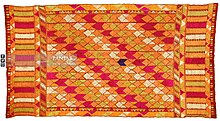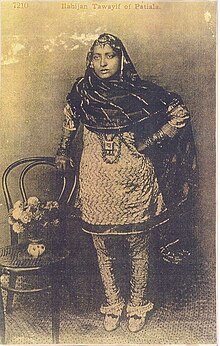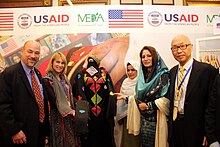Phulkari
Europe North America Oceania Phulkari (Gurmukhi: ਫੁਲਕਾਰੀ; Shahmukhi: پھلکاری) refers to the folk embroidery of the Punjab region and Gulkari of Sindh in South Asia.
[4] The main characteristics of phulkari embroidery are use of darn stitch on the wrong side of coarse cotton cloth with coloured silken thread.
Pal (1960) states that women would clean their courtyards and invite friends and family to ceremonially begin the process of embroidering a phulkari.
The mother and grandmothers would start embroidering Phulkari dupattas upon her birth because they believed that she would be the creator for future generations.
In Harishcharitra, the biography of the Emperor Harshavardhana (590-647 CE), the last ruler of great ancient Indian Vardhana empire, the seventh-century chronicler Bana wrote, "Some people were embroidering flowers and leaves on the cloth from the reverse side," which is a technical description of Phulkari embroidery.
[13] However, the earliest reference to the word phulkari is in Punjabi literature in the 18th century Waris Shah's version of Heer Ranjha, a legendary Punjabi tragic romance, which describes the wedding trousseau of the female protagonist Heer and lists various clothing items with phulkari embroidery.
The first extensive English publication on phulkari was by Flora Annie Steel in 1880 where she describes the various styles and exhibited the varieties in picture form.
[16] According to the employment of phulkari types "chaddar," "bhagh," or "chope," these khaddar characteristics vary in thickness, weight, and loose or firmly woven structures.
Cotton was grown throughout Punjab plains and after a series of simple processes it was spun into yarn by the women on the charkha (spinning wheel).
Animals and birds represented success, beauty, pride, and goodwill and different fruits symbolized wealth, prosperity, and fertility.
The decorated end of a scarf or shawl, the pallu, has separate panels of exquisite Phulkari workmanship with striking designs.
Thind makes reference to the contributions made by Mohinder Singh Randhawa in promoting the preservation of Phulkari art.
[5] Similarly, in contemporary modern designs, simple and sparsely embroidered dupattas (long scarf), odhinis (oversized long scarf), and shawls, made for everyday use, are referred to as phulkaris, whereas clothing items that cover the entire body, made for special and ceremonial occasions such as weddings are called baghs.
[8] Sainchi embroidery draws inspiration from village life and depict various scenes of everyday village life such as a man ploughing, lying on a charpai (jute cot), playing chaupar (a cross and circle board game), smoking hookah, or guests drinking sharbat (sweet cordial).
Common themes also include women performing chores like churning milk, grinding wheat flour on the chakki (hand mill), and working on the charkha (spinning wheel).
Birds, trains, circuses as well as scenes from popular Punjabi legends like Sohni Mahiwal and Sassi-Punnun were often depicted[9] The style also incorporates jewellery designs of bracelets, earrings, rings and necklaces.
Pal (1960) believes that such designs did no form part of the traditional method of embroidering Phulkaris but expressed a woman's wish to have such items of jewellery.
[8] The phulkari of south and southwestern Punjab in India and Pakistan has wide edges upon which designs of animals and birds are embroidered.
[26]Accordingly, in the past, as soon as a girl was born, mothers and grandmothers would start embroidering Baghs and Phulkaris, which were to be given away at the time of marriage.
Renewed interest has only resulted from the refugee crisis after the 1947 partition whereby organisations encouraged women to embroider Phulkaris to make ends meet.
[20] In 2011, after a five-year-long legal case, Phulkari was awarded the geographical indication (GI) status in India, which means that after that only registered traders and manufacturers, from the states of Punjab, Haryana, and Rajasthan would be able to use the term for the traditional craft, and the patent information centre (PIC) of Punjab State Council for Science and Technology[29] would issue a logo or hologram to distinguish the product.
Over the years, the Indian and Punjab governments have been working towards promotion of phulkari embroidery, by organizing special training programs, fairs, and exhibitions.
[5] Since most of the women artisans creating phulkari are in the unorganized sector or work through middlemen, they do not make much money compared to an actual selling price of their product.
To overcome this, Punjab Small Industries and Export Corporation (PSIEC)[31] formed women self-help groups and cooperatives to sell directly and make more profits.
The Nabha Foundation launched the Phulkari Traditional Craft Program in 2007[35] to "empower the marginalized rural woman, generate sustainable home based employment."
The Phulkari Makers of Bassi Pathana [36] is a financially independent self-group which evolved from the vocational training initiatives at Mehar Baba Charitable Trust in 2009.
[38] Phulkari products can also be found at occasional bazaars at Dastkar,[39] at Diwali melas, at the Lota Shop at the National Crafts Museum[40] in New Delhi, the Punjab Handloom Emporium in Ludhiana,[41] and in some private chains like 1469.
[5][44] Phulkaris are now sold online on popular retail and fashion websites and apps and can be found in the homes of Punjabis as well as Indian handloom aficionados.
Phulkari embroidery is a painstaking and time-consuming art that strains the eyes, and, as many women work indoors with poor lighting, it leads to the deterioration of their eyesight over time.
[50] In the Punjab, temporary art using flour, called chowk poorana, is drawn on the floor for ceremonial or decorative purposes.














